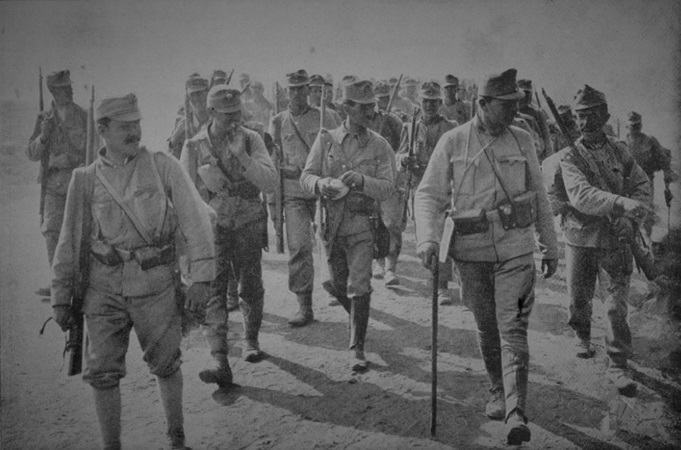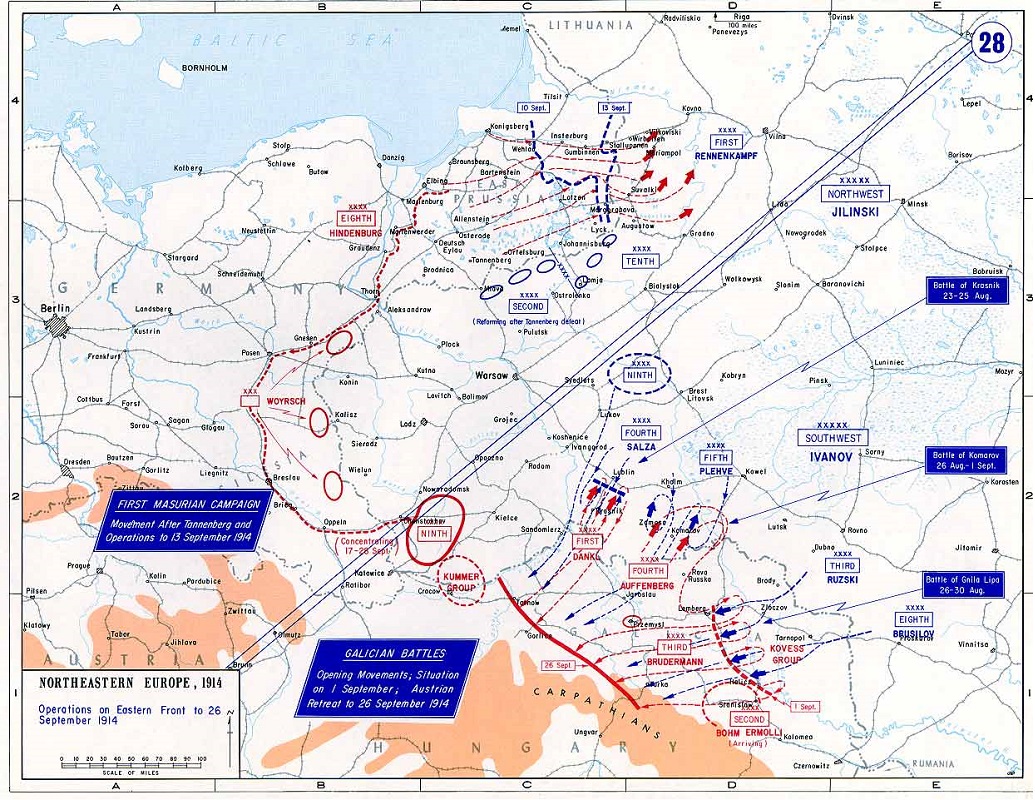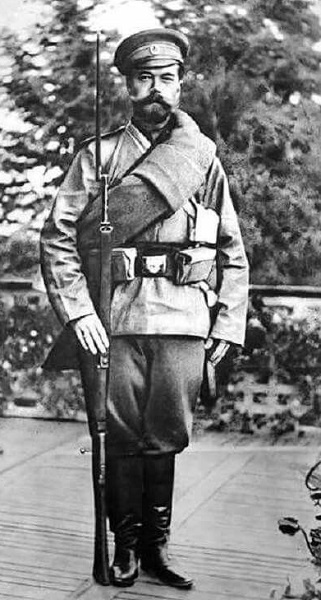● ● ●
For
clarity, Austro-Hungarian units are rendered in italics.
The Russian forces facing
the Austrians along the Galician frontier consisted of four
armies under an army group headquarters, Southwestern Front,
commanded by General of Artillery Nikolay Ivanov. Fourth
Army (General of Infantry Aleksei Evert)
and Fifth Army (General of Cavalry Pavel Pleve) stood
opposite the Austrian First and Fourth Armies;
Third Army (General of Infantry Nikolai Ruzsky) and Eighth
Army (General of Cavalry Aleksei Brusilov)
faced Third Army. There was no Austrian army group
headquarters; the high command (Armeeoberkommando or
AOK) controlled operations directly. The nominal Austrian
Commander-in-Chief was General of Cavalry Archduke
Friedrich, but actual command was exercised by the Chief of
Staff, Conrad von Hötzendorf.
After some preliminary
cavalry skirmishing, the main Austrian offensive commenced
on 22 August 1914. Because Stavka (the Russian high command)
had expected the enemy’s main effort to be made farther
south, the Austrians enjoyed numerical superiority in the
northern sector. First Army had ten infantry
divisions, one infantry brigade and two cavalry divisions
against Fourth Army’s six infantry divisions, one infantry
brigade and three cavalry divisions; Fourth Army and
Fifth Army were about equal in strength, though the former
with its high proportion of regular officers and NCOs was of
superior quality.

August 1914: Austrian
infantry on the march in Galicia
(Heeresgeschichtliches
Museum)
Farther south, Third Army
and the Kövess Group were detailed to screen the
right flank of Fourth Army. The latter was an ad hoc
formation under the commander of Third Army’s XII Corps,
consisting of that corps plus the few units of Second
Army that had reached Galicia from the Serbian front.
They were heavily outnumbered by the Russian forces in this
sector: Third and Eighth Armies between them had sixteen infantry
division and eight cavalry divisions to the Austrians’
eleven
infantry divisions and five cavalry divisions. Nor would the
belated arrival of the bulk of Second Army improve
matters substantially for the Austrians. With its
mobilization complete, the Russian Army’s margin of
superiority would continue to widen in the weeks ahead.
Conrad was well aware,
therefore, that unless his forces gained a quick victory in
the northern sector success was unlikely. And indeed, there
was, as he later said, “a happy beginning.” First Army
scored a considerable victory over Fourth Army in the Battle
of Krasnik (23-25 August), inflicting some 25,000 casualties
and driving the Russians back in disorder. Fourth Army
enjoyed similar success against Fifth Army in the Battle of
Komarów (26 August-2 September). This was a hard-fought
affair, as the Austrians enjoyed no superiority of numbers.
But Fifth Army had been shaken by the defeat of Fourth Army
on its right flank and its resistance collapsed. Casualties,
including 20,000 men made prisoner, were extremely heavy.
Had it not been for prompt action by Plehve, the army
commander, who ordered an immediate retreat, Fifth Army
might well have been encircled and destroyed.

The Eastern Front 1914:
Initial operations in East Prussia and Galicia (Department
of History, USMA West Point)
But these Austrian successes in the
north were more than offset by the increasingly ominous
situation farther south. Despite his success at Komarów
Auffenberg, the Fourth Army commander, fretted about
the security of his right flank, which was supposed to be
covered by Brundermann’s Third Army and the Kövess
Group. “We’re not in a good position,” he remarked to
his chief of staff, and he pointed out to Conrad that
Brudermann lacked sufficient forces to carry out his
mission.
Brudermann, however, was full of
fight. He implored Conrad for permission to go over to the
offensive against the Russians in his sector. Hitherto,
Third Army and the Kövess Group had remained
echeloned to the rear of Fourth Army, in line with
their task of flank protection—a task that was becoming more
and more difficult thanks to the non-appearance of Second
Army and the Russians’ growing strength. But scenting
victory after the “happy beginning” in the north, Conrad
yielded to his pugnacious subordinate’s entreaties: Third
Army was given permission to attack.
Seldom has a military action
been worse timed. Beginning on 26 August, Third Army
advanced with three corps—some nine divisions—against Third
and Eighth Armies, which between them had some twenty divisions
in eight corps. Third Army collided with this greatly
superior force on the line of the Zlota Lipa River, received
a thorough drubbing and was driven from the field. Near
Brzezany, the Kövess Group was also thrown back,
narrowly escaping encirclement in the process. Conrad
ordered a new line to be formed on the Gnila Lipa River,
which was possible only because the Russians took two days
to sort themselves out before resuming their advance.
Desperate to maintain the initiative, Conrad ordered III
Corps of Third Army to counterattack on 29
August. It was a fiasco. Overall, the Russians had 292
infantry battalions and 1,304 guns against the Austrians’
115 infantry battalions and 376 guns. The Austrians were stopped
dead in their tracks, then driven back amid scenes of
panic and rout. In a single day of fighting III Corps
lost 20,000 men and almost 100 guns, effectively knocking it out as
a fighting force.

Tsar Nicholas II models the
Russian Army infantry field uniform introduced in 1912 and
worn in 1914 (Imperial War Museum)
Having been soundly
defeated, Third Army and the Kövess Group fled
to the west. The fortress of Lemberg fell to the Russians on
3 September. Only the arrival from Serbia of Second
Army’s VII Corps prevented a complete collapse.
Brudermann, once touted as the “boy wonder” of the Habsburg
Army, was ignominiously dismissed from his command.
And worse followed. Brundemann’s
stinging defeat fatally undermined the position of the
hitherto successful First and Fourth Armies.
Imagining that the Russians in the northern sector no longer
constituted a major threat, Conrad ordered Auffenberg’s
Fourth Army to sidestep to its right so as to succor the
shattered Third Army. This move had the unfortunate
result of creating a gap between First and Fourth
Armies, with nothing to fill it but some cavalry. Nor
were the Russians in the north down for the count.
Reinforcements had been flowing to Southwest Front and
Plehve’s Fifth Army was practically back up to strength. He
was ordered to attack and did so on 3 September. By 11
September the left flank of Fourth Army had been
smashed, compelling both it and First Army to
commence a retreat that only ended on the line of the
Carpathian Alps.
By 26 September almost all of
Austrian Galicia had fallen under Russian occupation. The
fortress city of Przemysl with its garrison of 100,000
Austrian troops was surrounded and besieged. In all, the
armies of Austria-Hungary had suffered some 500,000
casualties, including many irreplaceable professional
officers and long-service NCOs. Conrad von Hötzendorf’s
Galician debacle had inflicted a wound from which the
Austro-Hungarian Army was never to recover.